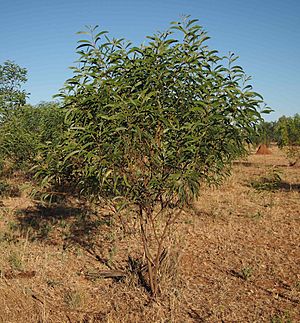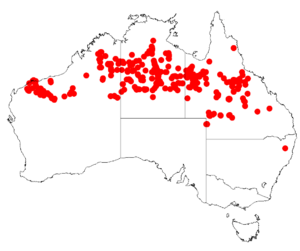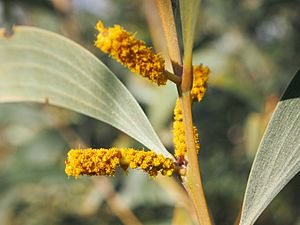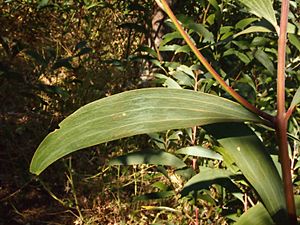Acacia elachantha facts for kids
Quick facts for kids Acacia elachantha |
|
|---|---|
 |
|
| Scientific classification | |
| Genus: |
Acacia
|
| Species: |
elachantha
|
 |
|
| Occurrence data from AVH | |
Acacia elachantha is a type of shrub, also known as a wattle, that belongs to the Acacia family. It grows naturally in the dry, desert-like areas of central and northern Australia.
Contents
What is Acacia elachantha?
This shrub is usually open and thin, growing about 1 to 5 meters (3 to 16 feet) tall. It has bright yellow flowers that bloom from July to October. The main branches grow upwards, and the plant has an open, spreading shape.
Leaves, Bark, and Flowers
The bark on most branches is smooth, thin, and grey. On older, main stems, it can become darker and have cracks running lengthwise. The leaves, called phyllodes, are a pretty silver-blue-green color. They are curved like a sickle and measure about 8 to 19.5 cm (3 to 7.7 inches) long and 7 to 22 mm (0.3 to 0.9 inches) wide.
The plant produces one or two flower spikes from each leaf joint. These spikes are light golden and are about 15 to 33 mm (0.6 to 1.3 inches) long. After the flowers bloom, red-brown to dark brown seed pods appear. These pods are straight or slightly curved, measuring 4 to 11 mm (0.16 to 0.43 inches) long and 3 to 4 mm (0.12 to 0.16 inches) wide. Inside the pods are dark brown to black seeds with a yellow cap.
Growth and Life Cycle
Acacia elachantha grows very quickly but does not live for a long time, usually dying after about five years. However, it makes a lot of seeds from a young age, so new plants can grow quickly to replace the old ones.
How it Got its Name
This plant was officially described by two botanists, Bruce Maslin and Maurice McDonald, in 1997. They wrote about it in a scientific journal. The first plant specimen used to describe the species was collected in 1995 near Birdsville, Australia.
The name elachantha comes from ancient Greek words. Elachys means "small" or "little," and anthos means "flower." This name refers to its smaller flower spikes compared to a similar plant called Acacia cowleana.
Where it Grows
Acacia elachantha is found in several parts of Australia. In Western Australia, you can find it in the Kimberley and Pilbara regions. It also grows across the Northern Territory, reaching into central and southwest Queensland, and even into the far northeast of South Australia.
This shrub mostly grows on sandy plains, in deep red sand or sandy soil. You might also see it along rivers or drainage areas, and on low rocky hills. It can even grow in places where the ground has been disturbed, like next to roads. It often grows with other tall shrubs or in open woodlands alongside Eucalyptus trees.
What it is Used For
Acacia elachantha is a very useful plant!
- Helping Soil: It can be used to help restore damaged soil because it can handle dry conditions, grows fast, and does well in poor soil.
- Food Source: The seeds of this plant are safe to eat and are very nutritious.
- Traditional Uses: The bark contains substances called tannins, which can be used to treat problems like diarrhea. The gum from the plant can also be used for similar purposes.
- Wood: The wood can be used for light building projects, as fuel for fires, or to make charcoal.
- Nitrogen Fixer: It is also a nitrogen fixing plant, which means it helps put important nutrients back into the soil, making it healthier for other plants.



